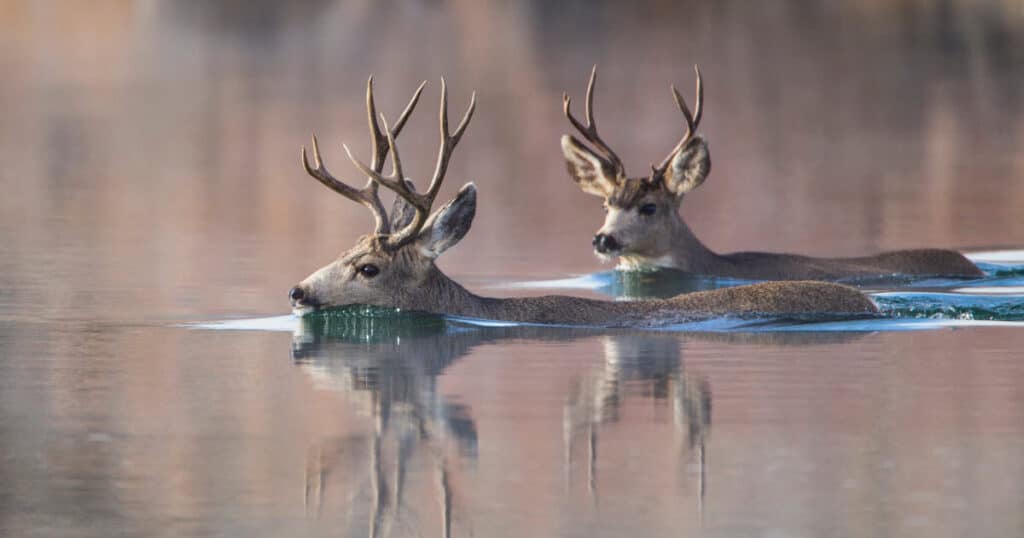For many people, there are few sights so odd as a deer swimming in the middle of a lake. You may wonder “Can deer swim?” or “Why do deer swim?” and you wouldn’t be alone. You will be surprised to learn that deer swim quite often, and the reasons why a deer chooses to swim can vary. In short – like everything else a deer does, it will swim in bodies of water if necessary for survival.
Answer: Yes, Deer Can Swim
Deer are excellent swimmers, reaching speeds of around 15 mph in the water. Deer sometimes cross lakes and rivers searching for food on the other side. In some cases, deer may even be seen swimming in the ocean. These animals are much stronger and more versatile than you probably imagined. The deer’s strong leg muscles, as well as its hooves and toes, are key to its ability to swim. Of course, deer will only swim if required to find food or keep safe. They primarily live on land.
There are some species of deer, such as the Korean water deer and Chinese water deer, with habitats in shallow parts of rivers. These water deer species have unique anatomy and behaviors that make them especially suited to swimming.
Why are Deer Such Good Swimmers?
There are several reasons why deer are such effective swimmers. These include:
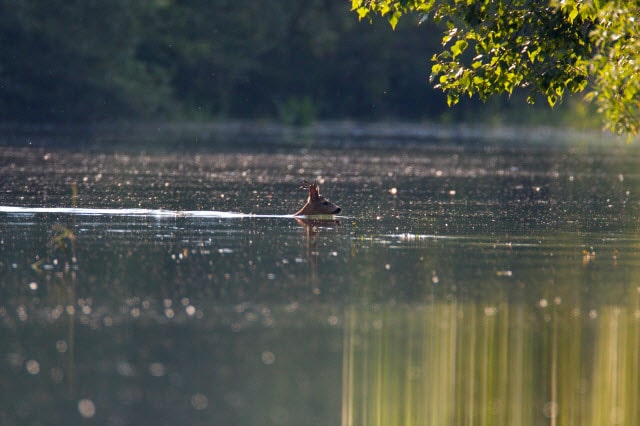
- Body shape: The deer’s body shape fits the task of swimming very well. A deer’s legs have outstanding power and stamina. The animal may swim as far as 10 miles, letting them get across rivers and most lakes with ease.
- Coat: The deer’s coat helps keep it safe in the water. It includes an undercoat and topcoat. The undercoat is woolly and denser than the topcoat. It gives the animal extra insulation, helping to prevent too much heat loss when in the water for long periods of time. The topcoat, by contrast, has long and hollow hairs. The topcoat creates buoyancy, meaning that enough of the animal’s body will stay above the water’s surface. When enough of the animal stays above the water, that cuts down on how much energy is used propelling the deer against the water’s resistance.
- Powerful Legs: Deer have powerful legs. The hind legs in particular have impressive stamina and strength. Leg movement propels deer as they swim in the water.
Why Do Deer Swim?
A deer will swim if it needs to get across a body of water to find food or to get away from danger. These animals have exceptional hearing, partly created by how special muscles let their ears move independently.
Deer also have an incredible sense of smell that will quickly inform them if there are any predators nearby. It seems that most of the time, a deer in the water is there because it has been frightened and wants to get away from danger.
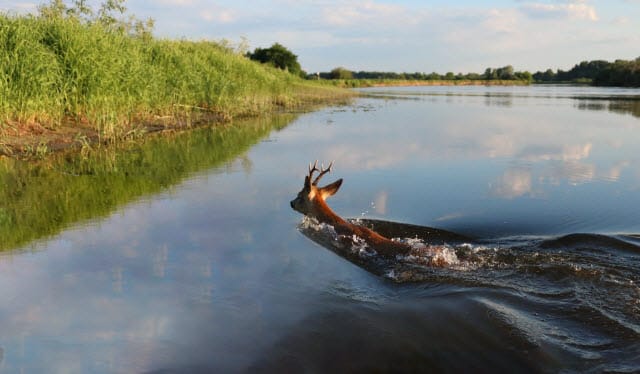
If you see a pregnant female deer swimming, it may be trying to reach a small island as a place to deliver her fawns and keep them safe.
An adult deer usually has enough energy to swim for long distances without danger of drowning. Baby deer (fawns) aren’t as good at swimming. They can become dangerously exhausted relatively quickly.
Another reason why a deer might end up swimming is because of how much the animal tends to like swamp ground. Deer may gravitate to swampy landscapes because of how many places there are to hide, with all the dense vegetation growth. There is also an abundance of food for deer in swampy areas.
Sometimes deer will spend more time in swamps during hunting season, to get away from that danger. It’s easier for deer to hear a hunter or predator pursuing them on swampy ground, because steps make more noise on dense and moist surfaces. Most deer are able to run fast – much faster than hunters and predators on marshy ground.
Water Deer are Even Better at Swimming
Species of deer considered water deer are even better swimmers than regular deer. Water deer species are smaller than other deer. Examples are Korean Water Deer and Chinese Water Deer.
Korean Water Deer are found in all areas of Korea. Their populations have become extremely large because their natural predators (Korean Tigers and Korean leopards) are endangered.
The Chinese Water Deer has gone extinct in the southern and western regions of China. Some of the areas of China where Chinese Water Deer are currently found in the wild include Fujian, Shanghai, Hubei, and Anhui.
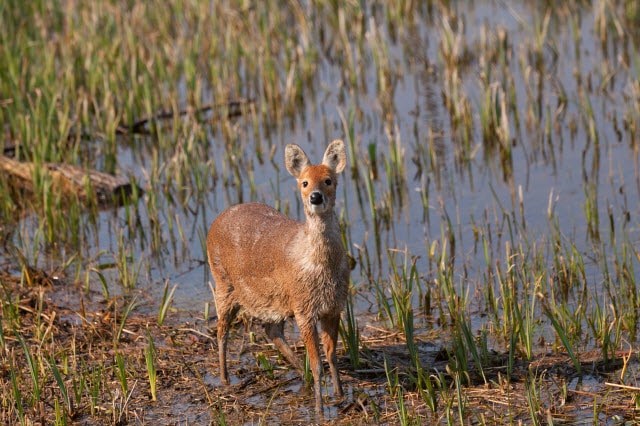
You can now even find Chinese Water Deer in the United States, the United Kingdom, and France. Chinese Water Deer tend to live near rivers in places where they can stay hidden in reeds and rushes.
These deer can sometimes be located in swamps and grasslands, and some will even make their home on mountains. Occasionally, they may be spotted in open cultivated fields.
What Do Water Deer Look Like?
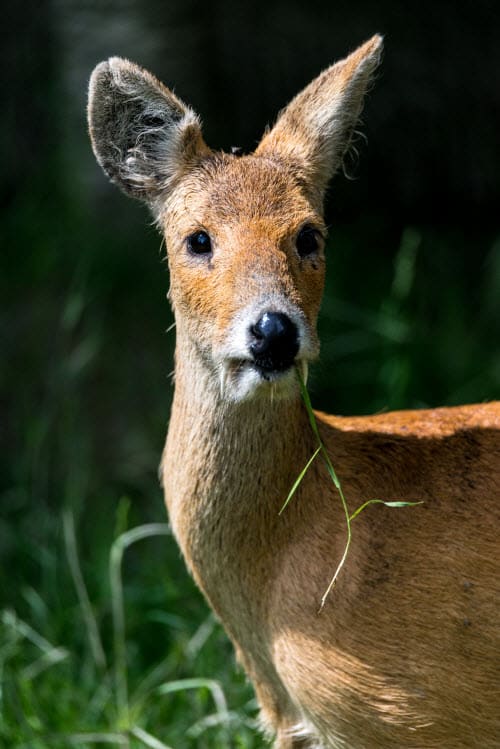
Water deer have a physical structure that makes them more effective swimmers.
They have narrows pectoral and pelvic girdles, long legs, and a long neck. They have especially long and powerful back legs.
In fact, their back legs are carried above shoulder height. Water deer jump in the same way as other deer.
They have ears with rounded edges, and water deer do not have antlers, growing short tusks which resemble fangs instead.
In the winter, water deer grow a summer coat that has a different color to the rest of the year. This summer coat is a light brown or grey-brown color.
When water deer are born, they have a dark brown coat with white spots and stripes on the upper torso area.
Water deer have distinct canine teeth, which are long and protruding in the upper jaw. These teeth will appear when the water deer is around six months old.
How Do Water Deer Behave?
Unlike other kinds of deer, water deer are solitary. The males are especially territorial. Females often come together with other females to form small groups during breeding season.
If danger appears, water deer will run away separately.
How Far are Deer Likely to Swim?
While water deer are the more highly skilled swimmers, every kind of deer can swim.
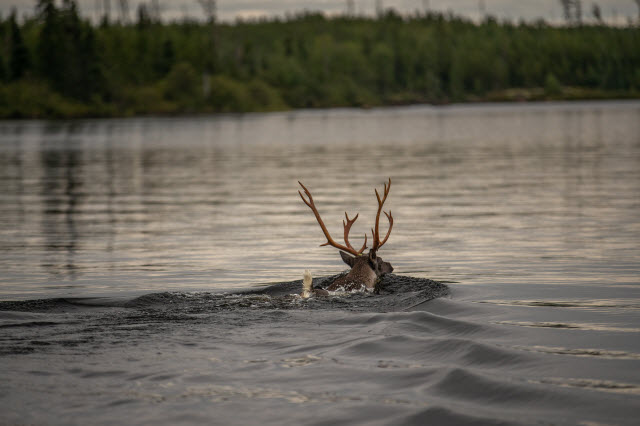
Even a white-tailed deer may swim as far as 10 miles. This means they can usually cross many rivers and lakes.
What to Do if You See a Deer Swimming?
Maybe you are wondering what you should do if you see a deer swimming in a lake, pond, or stream. Do you need to rescue the deer?
The answer is no. In most cases, you shouldn’t do anything at all.
If you think the animal might be in distress, you may call local wildlife authorities to let them know about the situation. You shouldn’t attempt to rescue the animal yourself. Doing so may lead to injury not only to yourself, but to the deer.
This is because you might use the wrong equipment or may distress the animal so much that it is no longer able to keep itself above water.
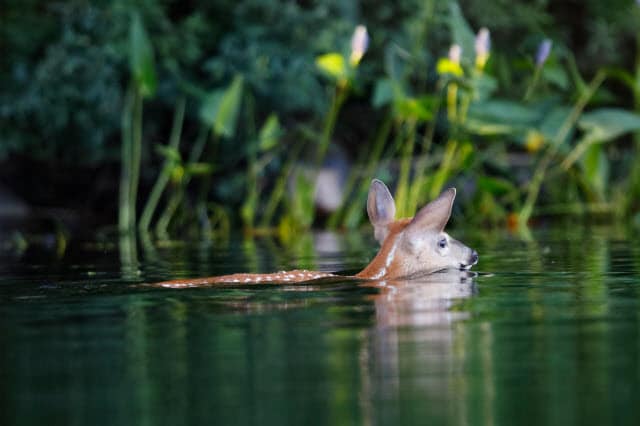
Wildlife authorities and rescue experts will have special equipment to keep themselves and the deer safe. If you’re concerned about the deer, monitor it and keep a safe distance so the animal does not feel threatened until the proper authorities arrive.
Can Deer Swim? You Bet.
If you don’t live in an area with deer, you are probably a bit surprised by how much they can do. Can deer swim? You bet – if they need to.
Like most wild animals, deer primarily focus on their survival.
It uses its ability to swim in situations where crossing a body of water is essential, such as if it needs to get away from a predator or reach a new source of food. Some deer will go for a swim to drown ticks on their body, or to escape mosquitoes and other bugs.
So the next time you’re on the water early in the morning, keep an eye out for a deer that’s out for a swim.

